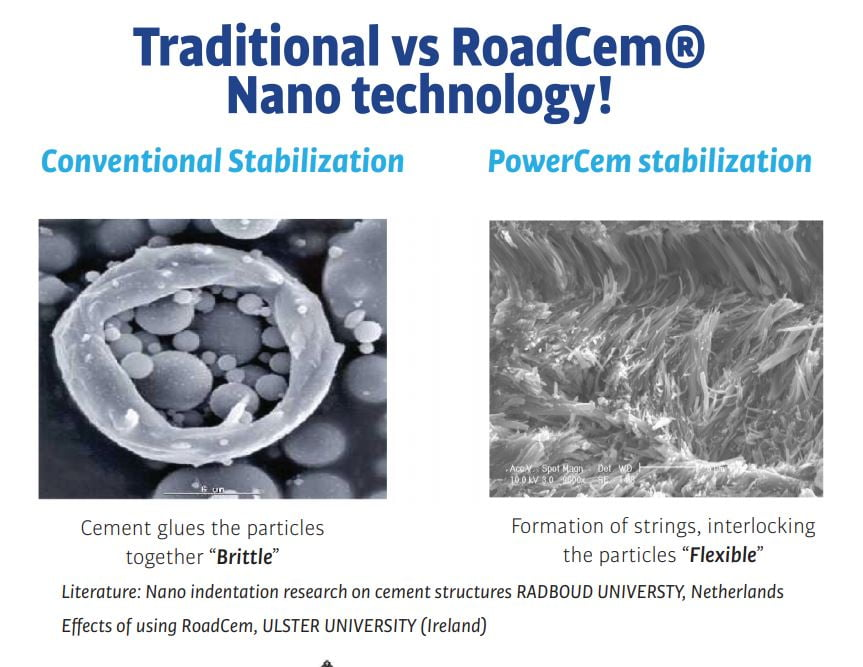What is the difference between Cement stabilisation and stabilisation with RoadCem added?
When stabilising soils with cement the hydration reactions are characterized by an early heat release after the initial mixing, then a dormancy period of about two hours in which no heat is released. After this during a 2 to 3 hour period further heat release is experienced during which the set continues. It has been established that the hydration reactions for cement are dependent on the water cement ratio and timing of these reactions. If cement alone is used the available water for the reactions can be used up in the early hydration process and pasting traps some dry cement powder, often up to 20% in the stabilisation. Wasting cement and causing variations in the bond formations.
RoadCem reduces these heat spikes and controls pasting to allow full hydration of the cement to take place.
Based on its hardening properties it has been identified that cement can effectively stabilise a wide variety of soils with the exception of organic soils, soils with sulphates and fine uniformly graded soils. The fineness of the cement particles often limits intimate contact with clayey soil fines. Adhesive bond formation is therefore compromised often resulting in reduced strength. It has been observed that uniformly graded materials require larger volumes of cement and are difficult to compact due to lack of interparticle aggregate interlock, which provides shear strength (the bag of marbles effect). The absence of larger granular particles also limits the maximum crushing or impact strength that can be achieved for fine-grained material only.
Silty soils are more susceptible to moisture variations, as they themselves can hold uncalculatable amounts of moisture. Therefore, cement strength cannot be predicted.
When RoadCem is used, with cement, all the basic reactions discussed remain the same but the products resulting from those reactions are different. The rate that these reactions take place and crystal formation is also very different.
Crystal density is increased by the addition of RoadCem this tends to use up any free water and with it any porous cell structures that would have occurred when cement alone has been used. This greatly improves the structural properties of the product resulting in greater strength and resistance to attack by water or water bound chemicals and acids.
As with cement, water is crucial in all the reactions. If less water is used there is an increase in the product strength, but workability of the mix is reduced.

Increasing water content reduces strength but does increase workability. Whilst potable water is needed with cement stabilisation. it is possible to use salt water with RoadCem and cement with very little deleterious effect on the strength of the final product. This is particularly useful when treating soils with high chloride and sulphate content. Chlorides and sulphates have been documented to inhibit standard cement hydration resulting in little or no strength gain (Ismaiel, 2006).
When RoadCem is used it creates a wrapping effect or encapsulation around the soils as opposed to a gluing effect provided by cement. It is this wrapping and encapsulating effect that is attributed with increased strengths of RoadCem, and cement bound products which result in high compressive strength, flexural strength and higher dynamic stiffness. With RoadCem the mechanism of stabilisation is through the formation of string like crystals which wrap around harmful or weak soil products such as organics or sulphates rendering them neutral or inert to the environment.

Commenti